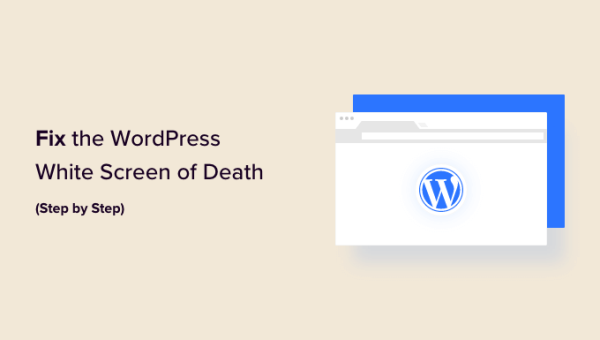How to fix the white screen of death (WSOD): in WordPress occurs when you see a blank white screen instead of your website’s content. This issue can be caused by a variety of reasons, including PHP errors, theme or plugin conflicts, or memory limit exhaustion.

What Causes the Issue
The following are often the cause of the (WSOD):
- Plugin compatibility issues
- Problems with your WordPress theme, especially if you’ve activated a new theme or created a new website on WordPress
- Missing or renamed theme directory. This error usually occurs when developers create a local development environment and clone the database, which may be missing or renamed.
How To Fix the Issue
1. Enable Debugging:
- Edit the
wp-config.phpfile in your WordPress installation. - Find the line that says
define('WP_DEBUG', false);and change it todefine('WP_DEBUG', true);. - This enables debugging, and any PHP errors will be displayed on the screen.
2. Check for PHP Errors:
- Reload the page, and you should see detailed error messages. These messages will help you identify the specific issue causing the WSOD.
3. Increase Memory Limit:
- In the
wp-config.phpfile, you can also try increasing the PHP memory limit:
define('WP_MEMORY_LIMIT', '256M');
4. Deactivate Plugins:
- If you can access the admin area, deactivate all plugins and check if the site loads. If it does, reactivate plugins one by one to identify the problematic ones.
5. Switch to Default Theme:
- Change your active theme to a default WordPress theme (e.g., Twenty Twenty-One). If the default theme works, your original theme might be causing the issue.
6. Check for Theme and Plugin Conflicts:
- If deactivating plugins and switching themes resolve the issue, it’s likely a conflict. You can isolate the problematic plugins or themes by activating them one by one.
7. Reupload Core Files:
- Download a fresh copy of WordPress from the official website.
- Replace the
wp-adminandwp-includesfolders on your server with the new ones.
8. Check File Permissions:
- Ensure that file and folder permissions are set correctly. Incorrect permissions might lead to issues loading files.
9. Review .htaccess File:
- Check the
.htaccessfile for any errors or incorrect configurations. Rename it temporarily to see if the issue persists (WordPress will generate a new one).
10. Database Issues:
- Corrupted or incomplete databases can cause the WSOD. You might need to repair your WordPress database using tools like phpMyAdmin.
11. Server Resource Limits:
- Check if your server is hitting resource limits such as CPU or memory usage. Your hosting provider can provide information on server resource usage.
12. Contact Hosting Support:
- If the issue persists, contact your hosting provider’s support. They can assist in identifying server-related problems.
13. Reinstall WordPress:
- As a last resort, you can reinstall WordPress. Make sure to back up your site before doing this.
14. Consult WordPress Forums:
- Visit the WordPress forums or community for assistance. Others may have experienced similar issues and can offer solutions.
Remember, before making any significant changes, it’s crucial to back up your website to avoid data loss. If you’re unsure about any step or if the issue persists, consider seeking professional help or consulting with your hosting provider’s support team.
Visited 6 times, 1 visit(s) today
Was this article helpful?
YesNo
Last modified: December 6, 2023



